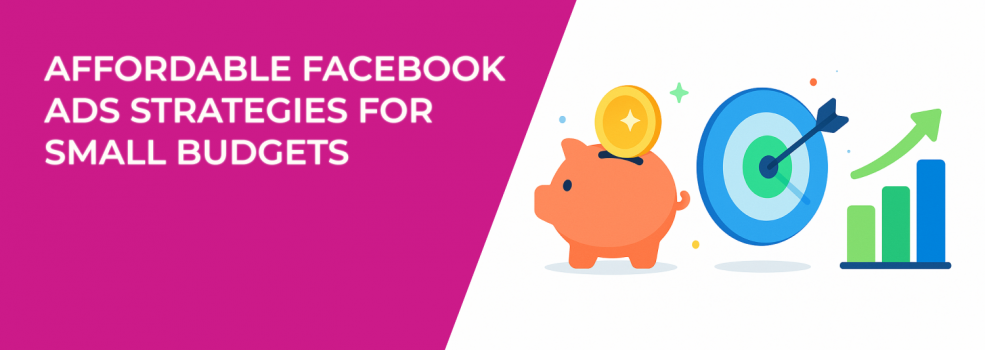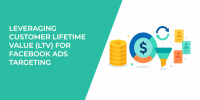It’s a common struggle — limited budget, limited time, but unlimited pressure to generate results. Many small business owners and marketers give up on Facebook Ads too soon, convinced that they’re only effective if you’re spending hundreds a day.
That’s simply not true. But to succeed with a small budget, you need to outthink the algorithm, not outspend your competitors.
Let’s walk through specific, affordable strategies to help you do just that.
1. Stop Guessing — Get Specific with Your Audience
When you’re working with limited funds, vague or broad targeting is the fastest way to waste money. You don’t need more reach — you need better focus.
Before launching a campaign, define a clear and narrow audience by considering:
-
Demographics, such as age, gender, and geographic location;
-
Interests, especially ones that are directly tied to your product or problem space;
-
Behaviors, like recent online purchases, engagement with similar brands, or use of specific devices.
In addition to interest-based targeting, small-budget advertisers should absolutely take advantage of custom audiences. These allow you to reach people who already have some relationship with your brand — which often means lower cost per result. You can create these audiences from sources like your website traffic, email list, or social engagement.
If you don’t have access to these data sources yet, makes it easier by helping you create custom audiences from Facebook group members, Facebook page followers, and Instagram account followers — all valuable segments that you can retarget directly in Meta Ads Manager.
By narrowing in on the most relevant traits and leveraging warm audience data, you give the algorithm a better signal, shorten the learning phase, and reduce wasted impressions. For a more detailed breakdown, explore Facebook Ad Targeting 101 — it will help you avoid the most common mistakes in early-stage audience building.
Once you’ve identified your top segments, don’t be afraid to test them individually. That way, you can isolate what works without overspending across the board.
2. Match Your Objective to the Result You Actually Want
Facebook’s algorithm isn’t designed to read your mind — it’s designed to follow your instructions. If you pick the wrong objective, you’ll get results that look good on paper, but don’t impact your bottom line.
Here are three ad objectives that tend to work best for small budgets:
-
Engagement, if your goal is brand visibility or warming up a cold audience;
-
Leads, especially with Facebook’s native forms that reduce drop-offs;
-
Conversions, but only if you already have enough data and a clean funnel.
The key is to align your campaign objective with your business stage and your actual goal — not what “sounds right” in theory. If you’re unsure how to choose, Meta Ad Campaign Objectives Explained offers a helpful side-by-side breakdown.
Choosing the right objective ensures Facebook’s delivery system works in your favor, not against it. And when every dollar matters, that precision pays off quickly.
3. Use Ads Manager — Not the Boost Button
It’s tempting to hit the blue “Boost Post” button — especially when Facebook keeps pushing it. But it’s rarely a good use of your money.
Using Meta’s full Ads Manager gives you much more control, allowing you to:
-
Select exact placements, so your ads show where they perform best;
-
Track real conversions, not just vanity metrics;
-
Split test audiences, creatives, or messaging efficiently;
-
Adjust budgets by ad set, which helps you identify top performers faster.
If you’ve been relying on boosts and haven’t seen real returns, it’s time to upgrade your setup. Why You Shouldn’t Boost Facebook Posts walks you through the shift — and what to do instead.
Once you’ve moved into Ads Manager, you’ll quickly notice how much more cost-efficient your campaigns become, even if your total budget stays the same.
4. Manually Choose the Most Effective Placements
Facebook loves to suggest “automatic placements,” but on a small budget, this usually results in your ad being served where it's cheapest — not where it works best.
Start with the platforms and locations that consistently drive results, such as:
-
Facebook Feed, which tends to offer strong reach and stable cost per click;
-
Instagram Feed, especially for lifestyle or visual-first brands;
-
Stories, both on Facebook and Instagram, where short videos often convert cheaply.
These placements give your creative the most room to stand out and allow for better visual storytelling. Once your campaigns generate data, you can test broader placement strategies. Until then, keep things lean and focused.
Even one poorly performing placement can inflate your cost per result. That’s why trimming the fat early on makes a huge difference for smaller campaigns.
5. Create Simple, High-Impact Creative That Converts
Good creative doesn’t have to be expensive — it just needs to be clear, relevant, and fast to capture attention. In fact, overproduced content can sometimes feel like an ad, which lowers trust.
Here are a few affordable and effective creative formats:
-
User-generated content (UGC), such as short testimonials or selfie-style demos;
-
Simple video walkthroughs, showing how the product works in real life;
-
Carousel ads, which can highlight product features, reviews, or step-by-step visuals.
All of these can be created in-house using a smartphone and free tools. If you want proof that polish isn’t everything, read Simple vs. Polished: Why Basic Facebook Ads Often Win.
Ultimately, creative is your first impression — and on a small budget, that impression needs to convert.
6. Retarget for as Little as $1 a Day
Even if you’re spending just $5 per day, you should still set aside $1 or $2 for retargeting. Why? Because people who already engaged with your brand are much more likely to take action.
Effective retargeting campaigns might include:
-
Reminder ads, for people who viewed a product but didn’t buy;
-
Limited-time offers, to create urgency and close the sale;
-
Social proof, like testimonials or reviews, to build credibility.
Retargeting is one of the most efficient ways to reduce your CPA — even more so when combined with warm audience segmentation. Not sure how to set it up? Start with this practical guide to Facebook retargeting.
Retargeting isn’t a bonus strategy — it’s a core part of making a small budget perform like a big one.
7. Monitor the Metrics That Actually Matter
Let’s be clear: likes and comments aren’t results. When every dollar matters, you need to track performance through the metrics that directly reflect campaign success.
Here’s what you should be watching:
-
Click-through rate (CTR), to see if your ad is relevant to your audience;
-
Cost per click (CPC), to monitor traffic efficiency;
-
Cost per action (CPA), to calculate the true cost of conversions;
-
Delivery warnings, such as “Learning Limited” or “Ad Set May Get Zero.”
Those warnings aren’t just technical details — they tell you when your ad is failing to exit the learning phase, or won’t get delivered at all. If you see them, fix them fast. Start with Why You See ‘Ad Set May Get Zero’ — it breaks down how to recover without pausing your whole campaign.
Keeping your campaigns lean also means knowing when to kill underperformers and double down on winners. Let the data guide you — not your assumptions.
Final Thoughts: Make Every Dollar Count
If your Facebook ads aren’t working, it’s probably not because your budget is too small. It’s because your strategy needs refining. With the right tactics, even a $5 daily budget can drive clicks, conversions, and long-term growth.
So next time you build a campaign, ask yourself:
-
Am I targeting the right people — specifically and intentionally?
-
Does my creative explain, persuade, and stand out within 2 seconds?
-
Am I optimizing for the right actions — not just reach or clicks?
-
Is my retargeting set up and running — even at a small scale?
Answering "yes" to all four puts you ahead of the curve — and makes your budget go much, much further.

